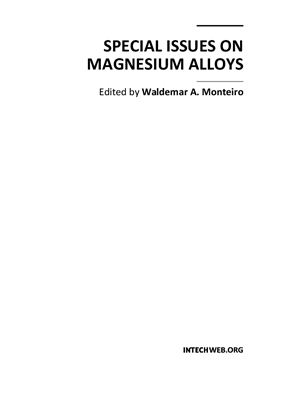InTech, Rijeka, Croatia, 2011, 128 pages
Magnesium is the lightest of all the metals and the sixth most abundant on Earth. Magnesium is ductile and the most machinable of all the metals. Magnesium alloy developments have traditionally been driven by requirements for lightweight materials to operate under increasingly demanding conditions (magnesium alloy castings, wrought products, powder metallurgy components, office equipment, nuclear applications, flares, sacrificial anodes for the protection of other metals, flash photography and tools). The biggest potential market for magnesium alloys is in the automotive industry. In recent years new magnesium alloys have demonstrated a superior corrosion resistance for aerospace and specialty applications. Considering the information above, special issues on magnesium alloys are exposed in this book: casting technology; surface modification of some special Mg alloys; protective carbon coatings on magnesium alloys; fatigue cracking behaviors of cast magnesium alloys and also, magnesium alloys biocompatibility as degradable implant materials.
Casting Technology and Quality Improvement of Magnesium Alloys
Surface Modification of Mg Alloys AZ31 and ZK60-1Y by High Current Pulsed Electron Beam
Estimation of Carbon Coatings Manufactured on Magnesium Alloys
Fatigue Cracking Behaviors and Influence Factors of Cast Magnesium Alloys
Biocompatible Magnesium Alloys as Degradable Implant Materials - Machining Induced Surface and Subsurface Properties and Implant Performance
Magnesium is the lightest of all the metals and the sixth most abundant on Earth. Magnesium is ductile and the most machinable of all the metals. Magnesium alloy developments have traditionally been driven by requirements for lightweight materials to operate under increasingly demanding conditions (magnesium alloy castings, wrought products, powder metallurgy components, office equipment, nuclear applications, flares, sacrificial anodes for the protection of other metals, flash photography and tools). The biggest potential market for magnesium alloys is in the automotive industry. In recent years new magnesium alloys have demonstrated a superior corrosion resistance for aerospace and specialty applications. Considering the information above, special issues on magnesium alloys are exposed in this book: casting technology; surface modification of some special Mg alloys; protective carbon coatings on magnesium alloys; fatigue cracking behaviors of cast magnesium alloys and also, magnesium alloys biocompatibility as degradable implant materials.
Casting Technology and Quality Improvement of Magnesium Alloys
Surface Modification of Mg Alloys AZ31 and ZK60-1Y by High Current Pulsed Electron Beam
Estimation of Carbon Coatings Manufactured on Magnesium Alloys
Fatigue Cracking Behaviors and Influence Factors of Cast Magnesium Alloys
Biocompatible Magnesium Alloys as Degradable Implant Materials - Machining Induced Surface and Subsurface Properties and Implant Performance

